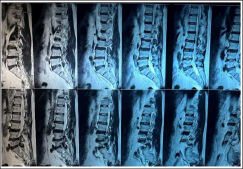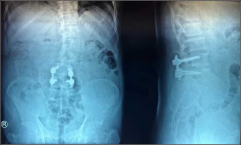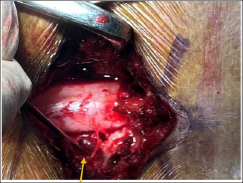Translate this page into:
A case report on dilated engorged epidural vein causing sciatica
*Corresponding author: Krishnakumar R, Department of Spine Surgery, Medical Trust Hospital, Kochi, Kerala, India krishnakumar.ram@gmail.com
-
Received: ,
Accepted: ,
How to cite this article: Krishnakumar R, Vijaya Anand S. A case report on dilated engorged epidural vein causing sciatica. J Orthop Spine 2023;11:76-78. doi: 10.25259/Joasp_41_23
Abstract
Sciatica is most of the time due to lumbar disc herniation. Some other pathologies such as aneurysmal bone cysts, proximal femur osteomyelitis, arachnoid cysts, facetal cysts, giant cell tumours, and pyriformis syndrome mimic sciatica are termed sciatica mimickers in literature. In this case report, we present a 66-year-old man with low back pain and left sciatica and neurogenic claudication who underwent transforaminal lumbar interbody fusion L4–5. In magnetic resonance imaging, the finding was degenerative changes with foraminal stenosis of L4–L5, but intraoperatively, we found an engorged epidural vein causing the compression of L4 exiting nerve root. The engorged epidural vein sometimes can cause sciatica which mimics the disc herniation.
Keywords
Engorged epidural vein
Lumbar canal stenosis
Neurogenic claudication
Sciatica
Sciatica mimiker
INTRODUCTION
Sciatica is the pain radiating from the back to thigh, leg and to the foot. Although disc herniation is the most common cause of sciatica, other pathologies such as pyriformis syndrome, facetal cysts, proximal femur osteomyelitis also can cause this condition. These are called as Sciatica mimikers. Engorged epidural vein can be severe enough to produce this classical symptom mimiking sciatica.
CASE REPORT
A 66-year-old male obese patient presented us with complaints of back pain with left lower limb radicular pain for one year. On further clinical examination, he had diffuse lower lumbar region tenderness with straight leg raising test positive for 45° on the left side. He also has sensory dulling over the left lower limb. His bowel and bladder were intact. His motor power on the left lower limb was normal. Other neurological tests were unremarkable. He was ordered with radiological investigations. Radiographs were taken of Lumbosacral spine anteroposterior and bending films, showing degenerative changes at the lumbar region with degenerative scoliosis to the right side and decreased disc space at L5-S1 space. Magnetic resonance imaging (MRI) was carried out; it showed degenerative changes at various levels [Figure 1a and 1b]. At the L4–L5 level, foraminal stenosis on the left side was noted. He was prescribed analgesics and physical therapy for a short period of time, but he did not improve symptomatically. He was given the option of epidural steroid injection with the continuation of physical therapy. After a one-month interval, he was reassessed. He has not improved significantly with persisting left sciatica. We discussed with the patient the surgical option. He was given an option of surgical decompression of L4–L5 with a fusion procedure. After the consent and preoperative routine check, he was taken up for surgery. Under general anaesthesia with a posterior approach, L4–L5 transforaminal lumbar interbody fusion (TLIF) was done [Figure 2]. Intraoperatively, during the exploration of the L4 exiting nerve root, we found a large engorged epidural vein compressing the left L4 nerve root [Figure 3]. The vein was traced, isolated, and cauterized. The nerve root was made free of compression. After surgery, the patient’s left sciatica was reduced significantly, and other symptoms were also improved. After a one-month post-operative period, the patient was assessed with a visual analog scale scale, his pain score was less than three, and the walking distance was increased to more than 1500 meters.




DISCUSSION
The term sciatica refers to pain radiating from the back affecting the thigh, leg, and sometimes up to the foot.1,2 The most common aetiology of sciatica is compression of a nerve root due to lumbar disc herniation, but few conditions such as pyriformis syndrome, aneurysmal bone cyst, facetal cyst, proximal femur osteomyelitis, arachnoid cyst, epidural abscess, neurofibroma, metastasis, hemangiopericytoma, liposarcoma of nerve sheath were labelled as sciatica mimickers in literature.3 A few studies reviews on epidural varicose veins causing sciatica-like symptoms are also seen, where the epidural varicosis with or without underlying causes can cause sciatica mimiker.4
Our case report has demonstrated that dilated engorged epidural vein compressing the left L4 exiting nerve root causing sciatica-like symptoms. The patient became symptom-free following the surgery where he has undergone coagulation and resection of the dilated engorged epidural vein and TLIF L4–5.5,6 The dilated epidural vein can produce symptoms like sciatica were noted in the literature. Rarely the dilated epidural vein can be seen on MRI in T2 sagittal and T1 sagittal images. The dilated epidural vein can also compress the nerve root in the epidural spather than extruded disc or other lesions.
CONCLUSION
Dilated engorged epidural vein can also cause sciatica-like symptoms like sciatica mimickers.
Along with the desired procedure, coagulation and resection of dilated veins can relieve the symptoms in those patients when it is not evident in MRI.
Ethical approval
Institutional Review Board approval is not required.
Declaration of patient consent
Patient’s consent not required as patients identity is not disclosed or compromised.
Financial support and sponsorship
Nil
Conflicts of interest
There are no conflicts of interest.
Use of artificial intelligence (AI)-assisted technology for manuscript preparation
The authors confirm that there was no use of artificial intelligence (AI)-assisted technology for assisting in the writing or editing of the manuscript and no images were manipulated using AI.
REFERENCES
- Sciatica reporting in patients with low back pain: A rare case report in tertiary care teaching hospital. Sch J Med Case Rep. 2014;2:176-8.
- [Google Scholar]
- Epidural varicosis as a possible cause of radicular pain: A case report. J Med Case Rep. 2011;5:537.
- [CrossRef] [PubMed] [Google Scholar]
- Comparison of minimally invasive surgery transforaminal lumbar interbody fusion and TLIF for treatment of lumbar spine stenosis. J Healthc Eng. 2022;2022
- [CrossRef] [PubMed] [Google Scholar]
- Sciatica caused by a dilated epidural vein: MR findings. Eur Radiol. 1999;9:113-4.
- [CrossRef] [PubMed] [Google Scholar]






